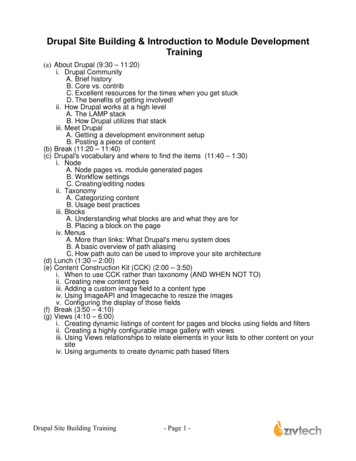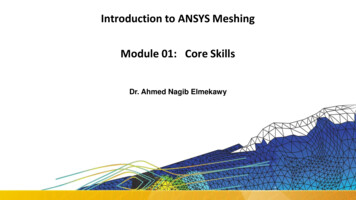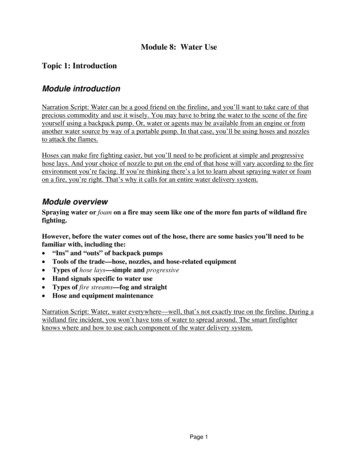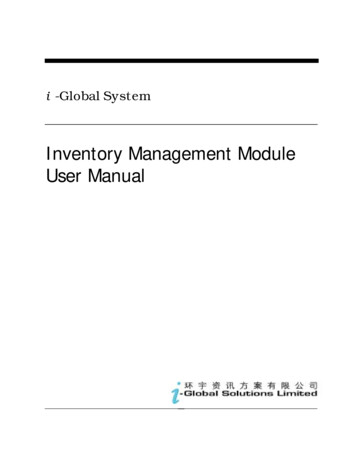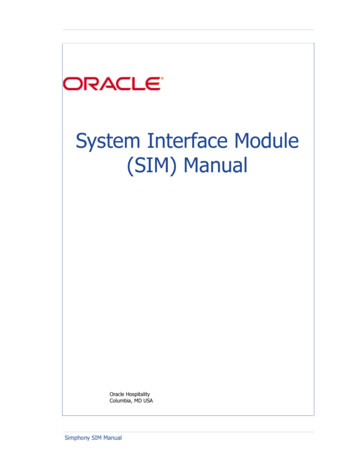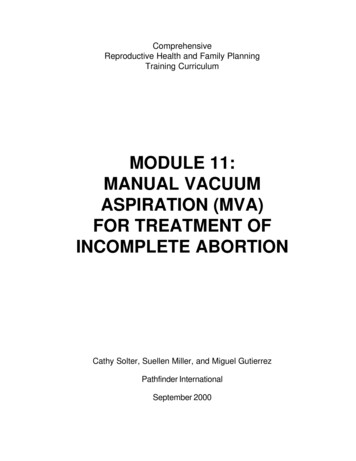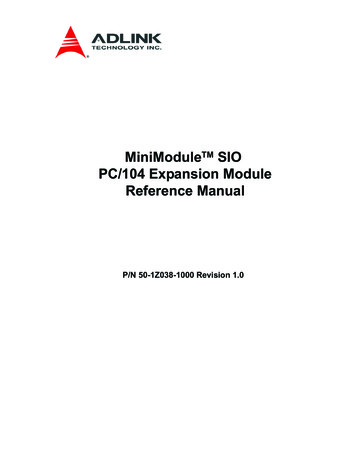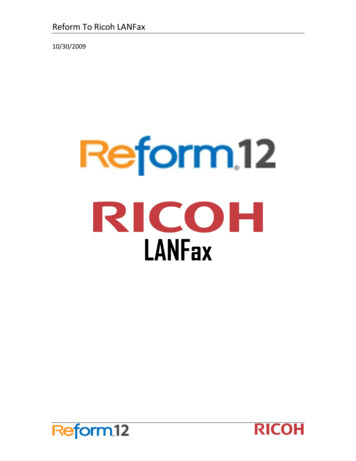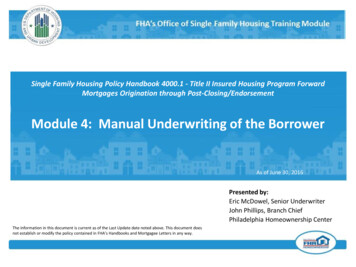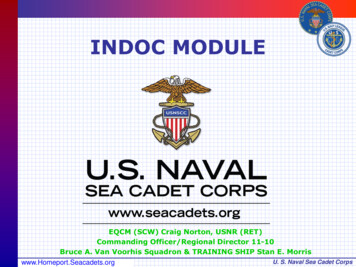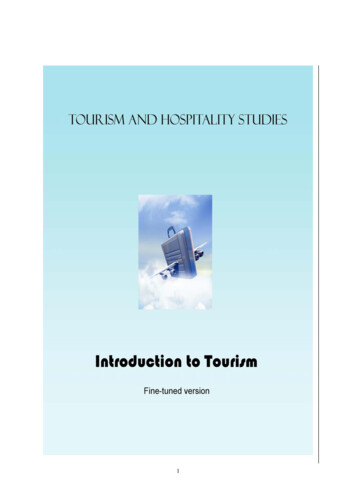
Transcription
1
Manual on Module IIntroduction to Tourism(Fine-tuned version)2
ByPersonal, Social and Humanities Education SectionEducation Bureau3
Copyright The Government of the Hong Kong Special Administrative RegionAll rights reserved.The copyright of this manual belongs to the Government of the Hong Kong Special AdministrativeRegion. Commercial use is strictly prohibited. Offenders will be liable to legal responsibility.Schools need not apply for permission to copy this manual in whole or in part for non-profit makingeducational or research purposes. All other uses should gain prior permission in writing from theGovernment of the Hong Kong Special Administrative Region. Requests should be directed to the:Education Bureau13/F, Room 1319, Wu Chung House213 Queen’s Road East,Wan ChaiHong Kong4
AcknowledgementsWe would like to express our gratitude to the following organizations for giving us the permission toreprint some of the pictures and /or providing us with information for completing the curriculum supportpackage:····The Association of National Tourist Office Representatives in Hong Kong, ANTOR (HK);Centre for Food Safety, Food and Environmental Hygiene Department;International Centre for Integrated assessment and Sustainable development (ICIS), atMaastricht University; andfreedigitalphotos.net - graphical images of the front cover as well as of the content5
IntroductionA set of curriculum support package of tourism and hospitality learning and teaching materials is beingdeveloped by the Personal, Social and Humanities Education Section of Curriculum DevelopmentInstitute, Education Bureau for the implementation of the senior secondary Tourism and HospitalityStudies fine-tuned curriculum in schools. The curriculum support package is comprised of five manuals,and they are developed to broaden students’ knowledge of the five different units of the Tourism andHospitality Studies curriculum.The content of this manual – Introduction to Tourism, should enhance students’ understanding of thedynamic nature of the tourism and hospitality industry. In addition, the manual includes activities todeepen students’ understanding and help them to apply theories and concepts. Furthermore, studentsshould be able to develop enquiry, problem-solving and decision-making skills through these activities.All comments and suggestions related to this curriculum support package may be sent to:Chief Curriculum Development Officer (PSHE)Personal, Social and Humanities EducationCurriculum Development InstituteEducation Bureau13/F, Room 1319, Wu Chung House213 Queen’s Road East,Wan ChaiHong KongJune 20136
Contents1. Introduction to Tourismp.101.1. Travel and Tourism as an Integrated Disciplinep.111.2. Integrated Model of Tourismp.121.2.1. Key Elements in the Integrated Model of Tourismp.131.2.2. Factors that Encourage / Prohibit the Development of Tourismp.151.3. History of Tourismp.161.4. Careers in the Tourism Sectorp.181.4.1. Job Opportunitiesp.181.4.2. Career Developmentp.192. The Meaning of 'Travel', 'Tourism' and 'Tourist'p.272.1. Concepts of ‘Travel’ and ‘Tourism’p.282.2. Definitions of ‘Tourist’p.312.3. Classification of Touristsp.342.3.1. Cohen’s Classificationp.342.3.2. Plog’s Classificationp.362.4.Tourist’s Codes of Behaviour and Other Concerned Issuesp.412.4.1. Tourist’s Codes of Behaviourp.412.4.2. Concerned Issues While Travelingp.452.4.3. Tourists with Special Needsp.463. Travel Motivations and Tourist Flowsp.483.1. Travel Motivations – Reasons of Travel / Purposes of Travelp.493.2. The Importance of Travel Motivations and Its Effects on Travelp.55Decisions3.3. Typologies of Travel Motivationsp.593.4. Concept of Tourist Flowsp.707
3.4.1. Factors Influencing Patterns of Tourist Flows4. Tourism Products - Attractions and Destinationp.71p.794.1. Tourism Productsp.804.2. Planning of Tourism Products and Destinationsp.834.2.1. Product Life Cycle and Its Applications in Tourism Product Planningp.834.2.2. Role and Importance of Planning in Destination Developmentp.914.3. Carrying Capacityp.935. Different Sectors of the Tourism Industry and Their Rolesp.955.1. Classification of Sectors and Their Linkagesp.965.2. Private Sectorsp.985.2.1. Hospitalityp.985.2.2. Transportationp.995.2.3. Intermediatesp.1065.2.4. Other Private Sector Facilitatorsp.1175.3. Public Sectorsp.1205.3.1. The Major Roles of Government in Tourism Developmentp.1205.3.2. Government Departments and Public Tourism Organizationsp.122Involved in Tourism5.3.3. The Case of Hong Kong – The Role and Work of the Hong Kongp.126SAR Government and Key Local Tourism Organizations5.3.4. Key International Tourism Organizations6. The Local Tourism Industryp.135p.1456.1. The Development of Tourism in Hong Kongp.1466.1.1. Overview of Tourism Performancep.1466.1.2. Factors that Facilitate the Development of Tourism in Hong Kongp.1466.2. Visitor Profilep.1488
6.2.1. Analyzing Tourism Statisticsp.1486.2.2. The Trends of Inbound Tourism Market in Geographic, Demographic,p.152Psychographic and Socio-economic Aspects6.3. Tourism Resources in Hong Kongp.1537. The Impacts of Tourismp.1737.1. The Social and Cultural Impacts of Tourismp.1747.1.1. Positive Impacts on the Social and Cultural Aspectsp.1747.1.2. Negative Impacts on the Social and Cultural Aspectsp.1767.1.3. Measurement of Social and Cultural Impactp.1797.1.4. Conclusionsp.1807.2. Economic Impacts of Tourismp.1817.2.1. Positive Impacts on the Economyp.1817.2.2. Negative Impacts on the Economyp.1847.2.3. Measurement of Economic Impactp.1867.2.4. Conclusionsp.1907.3. Environmental Impactsp.1917.3.1. Positive Impacts on the Environmentp.1917.3.2. Negative Impacts on the Environmentp.1927.3.3. Measurement of Environmental Impactp.1947.3.4. Conclusionsp.195List of Tables and Figuresp.1979
1. Introduction to Tourism10
1.1. Travel and Tourism as an Integrated DisciplineTourism embraces nearly all aspects of our society. Apart from its importance to economic changes,human socio-cultural activities and environmental development, tourism is related to other academicsubjects such as geography, economics, history, languages, psychology, marketing, business and law,etc. Therefore, it is necessary to integrate a number of subjects to study tourism. For example, subjectssuch as history and geography help us understand more about the development of the historical andgeographical resources of a tourist destination. Besides, subjects like marketing and business help usunderstand the promotion and marketing of tourism products. The study of information technologyenhances our understanding of the importance of the global distribution system and its effect ontourism business. The study of religion and culture provides information on the cultural resources of adestination and opportunities to develop it as a cultural destination. Tourism is so vast, so complex, andso multifaceted that there is a wide range of subjects related to tourism. Figure 1.1 shows someacademic subjects which are related to tourism studies with corresponding examples.Figure 1.1 – Integrated Disciplinary Model of Tourism StudiesSource: Integrated Disciplinary Model (adopted from Jafari, Jafar, Ritchie, J.R. Brent, Towards a Framework for TourismEducation: Problems and Prospects, Annals of Tourism Research, 1981, VIII (1).11
1.2. Integrated Model of TourismThe vast majority of businessorganizations such as travel agents,meeting planners, and other serviceproviders including inment are classified as traveland tourism related business. In practice,these organizations are closely linked inthe provision of services to the travellers.Tourism is so vast, so complex, and somultifaceted that the practitioners needto obtain a wide range of knowledgerelated to tourism.Figure 1.2 – Integrated Model of TourismSource: Cook, Roy A., Yale, Laura J., Marqua, Joseph J., Tourism – The Business of Travel, 2nd ed., Prentice Hall, 2001,p.6-812
1.2.1. Key Elements in the Integrated Model of TourismFigure 1.2 shows the key elements in the integrated model of tourism. This model summarizes how keytourism stakeholders interact with each other and respond to the changes of the external environment.Detail descriptions of these elements are provided as follow:1) TravellersTravellers are at the centre of the model where all tourism activities are focused. Radiating from thecentre are three large bands containing several interdependent groups of tourism participants andorganizations.2) Tourism PromotersTourism promoters are in the first layer, in close contact with the travellers. Organizations in this layerinclude tourism boards, direct marketing companies, meeting planners, travel agents and tour operators.The tourism boards and direct marketing companies provide information and marketing services totravelers whereas travel agencies, tour operators and meeting planners provide services such asmaking travel arrangements and giving professional advice on tourism related matters. All theseorganizations usually deal directly with individual travellers.3) Tourism Service SuppliersTourism service suppliers, such as airline companies, bus operators, railway corporations, cruise shipoperators, hotels and car rental companies, etc. usually provide services to travellers independently.The service suppliers may also collaborate to provide tour packages for travellers by combining thevarious services such as accommodation, air transportation, theme park entrance ticket, etc.4) External EnvironmentAll of the participants, either individually or as a group, are constantly responding to a variety ofsocietal/cultural, political, environmental, economic and technological forces. It is the interaction ofthese forces that determine how closely the individuals and organizations work together.(i)Societal/Cultural forcesSuch as the local skill and know how, the indigenous cultures of the destination and theattitude of local people towards the tourists would have a significant impact on the touristexperience in a destination. One example of encouraging the local community to take part intourism is the “Be a Good Host” campaign launched by the Hong Kong Tourism Board. Itaims at enhancing the tourist experience which helps to promote Hong Kong through“word-of-mouth”.(ii)Political forcesSuch as government support on infrastructure, its policy on tourism planning, the diplomaticrelations between tourist generating countries and tourist destination countries, etc.determines the environment of tourism development. For example, because of politicalinstability in the Middle East, tourism development in the region and the attractiveness ofthese countries to tourists has been adversely affected.13
(iii) Environmental forcesSuch as the problems of congestion, pollution, hygienic conditions, loss of green beltscaused by excessive urbanization and development of tourism may destroy the pleasantambiance of the destination which visitors look for. For example, Hong Kong’s air pollutionproblem as a factor discourages tourists to come to Hong Kong.(iv) Economic forcesSuch as the disposable income of tourist and the affordability of a destination affect thedesire to travel. For example, in Hong Kong, due to the economic crisis I 1997, the numberof visitor arrivals in particular from Asia recorded a negative growth in 1998. (StatisticalReview, Hong Kong Tourism Board, 1999). In the recent 2008 global financial crisis, HongKong Tourism Board showed that visitor arrivals in November was 1.1% less than inNovember 2007.(v)Technological forcesSuch as the popularity of using the Internet for searching information, reservation orpurchasing of tourism products affect the tourists’ buying behaviour. The traditional way ofdistributing tourism products through intermediaries, such as travel agents, tour wholesalersis facing a great challenge. Now that travellers can deal directly with the suppliers, such asairlines, hotels, operators of attractions to purchase tourism products, they can almostby-pass travel agents.14
1.2.2. Factors that Encourage / Prohibit the Development of TourismAs seen in the above section, changes of various factors, including social, cultural, political,environmental, economic and technological forces could lead to both positive and negative effects ontourism. The influences of these factors on tourism development are unique and could be different indifferent countries. Further explanations about their impacts on tourism and travel motivations areprovided in Table 1.1 below.FactorsSocial FactorsDescriptionDemographic trends and social changes will have important impacts on the futuredevelopment of the industry. The fact that people are living longer, the fall in the numberof young people, the increase in one parent households, more couples choosing not tohave children or delay having children. They all point to the fact that the type of traveland tourism products and services will change radically. Example: the aging populationwill be an opportunity for the cruise travel market where seniors are their key targetgroups.Political FactorsPolitical factors can lead to huge impacts on tourism development. The factors are thepolicies in encouraging tourism activities such as investment in tourism relatedinfrastructures, openness in travel visa applications and favourable foreign tourisminvestments. Finally, the political stability of the country in particular is the major factor.One obvious example was the continuing clashes between government anddemonstrators in the capital of Thailand – Bangkok in 2010. The political instability hadresulted to serious negative effect on its’ national tourism business. Many visitorsdecided to postpone and cancel their trips to Bangkok which finally led to severe loss ofincome generated by tourism businesses.Economic FactorsWhether the global economic environment is healthy or not would affect people’sintentions of travelling to other countries. People tend to spend more on travelling if theyare under a favourable economic environment. For example, the appreciation of RMB toHKD has encouraged much more Mainland visitors travelling to Hong Kong since theyperceived a higher value of their currency when spending their money in Hong Kong.Cultural andEnvironmentalFactorsA greater environmental awareness and a society that takes its health and fitness moreseriously than it was in the past. This awareness has affected travel and tourismdevelopments in the recent years. 'Green issues' such as the development ofeco-tourism, green hotels and conservation of heritage sites are becoming more andmore important which provide a basis for sustainable tourism development of a touristdestination.TechnologicalFactorsTravel and tourism has always been an industry that has made extensive use of newtechnological equipment. Computerized reservation system (CRS), the use ofcomputers and sophisticated databases for marketing purposes are very commonamong travel agencies. Increasing competition within the industry force agencies to usenew technology to its fullness. Latest developments in transportation make extensiveuse of new technology, for example the Mainland’s High-speed Rail and the advances inaircraft design help opening up new long-haul destinations.Table 1.1 – Factors that Encourage or Prohibit the Development of TourismSource: The Development of the Travel and Tourism Industry and the Factors Affecting it Today. Retrieved fromhttp://www.123HelpMe.com/view.asp?id 14919915
1.3. History of TourismThe history of tourism can be divided into 6 different stages as follow:1) Roman Empire PeriodDuring the Roman Empire period (from about 27 BC to AD 476), travel developed for military, trade andpolitical reasons, as well as for communication of messages from the central government to its distantterritories. Travel was also necessary for the artisans and architects “imported” to design and constructthe great palaces and tombs. In ancient Greece, people traveled to Olympic Games. Both theparticipants and spectators required accommodations and food services. Wealthy Romans, in ancienttimes, traveled to seaside resorts in Greece and Egypt for sightseeing purpose.2) Middle Age PeriodDuring the Middle Age (from about AD 500 to 1400), there was a growth of travel for religious reasons.It had become an organized phenomenon for pilgrims to visit their “holy land”, such as Muslims toMecca, and Christians to Jerusalem and Rome.3) 16th CenturyIn the 16th century, the growth in England’s trade and commerce led to the rise of a new type of tourists- those traveled to broaden their own experience and knowledge.4) 17th CenturyIn the 17th century, the sons and daughters of the British aristocracy traveled throughout Europe (suchas Italy, Germany and France) for periods of time, usually 2 or 3 years, to improve their knowledge.This was known as the Grand Tour, which became a necessary part of the training of futureadministrators and political leaders.5) Industrial Revolution PeriodThe Industrial Revolution (from about AD 1750 to 1850) in Europe created the base for mass tourism.This period turned most people away from basic agriculture into the town / factory and urban way of life.As a result, there was a rapid growth of the wealth and education level of the middle class, as well asan increase of leisure time and a demand for holiday tourism activities. At that time, travel for healthbecame important when the rich and fashionable Europeans began to visit the spa towns (such as Bathin England and Baden - Baden in Germany) and seaside resorts in England (such as Scarborough,Margate and Brighton).6) 19th to 20th CenturiesIn the 19th and 20th centuries, the social and technological changes have had an immense impact on16
tourism. Great advances in science and technology made possible the invention of rapid, safe andrelatively cheap forms of transport: the railways were invented in the 19th century and the passengeraircraft in the 20th century. World War II (AD 1939-1945) was also the impetus for dramaticimprovements in communication and air transportation, which made travel much easier today than inearlier times.- 1980sThe 1980s were called the boom years. Business and leisure travel expanded very rapidly. Thebaby-boomers were coming of age and had the money to spend. These travellers were looking for avariety of tourism products from exciting vacation options such as adventure travel, ecotourism andluxurious travel.There was not only a significant expansion in the travel market but also in tourist destinations. Thefall of the Berlin Wall in Germany in 1989 signified the doom of communism in Europe. Countriessuch as Russia and the Czech Republic became new tourist destinations both for vacation andbusiness travellers.- 1990sThe Aviation Industry was facing high operational costs, including wage, oil prices, handling fee ofCentral Reservation System (CRS), landing charge of the air crafts and advertising fee etc. Duringthis decade, CRS also marched towards more sophisticated technology. It became possible foragents to book a huge inventory of tourism products, such as hotels, car rentals, cruises, rail passes,and theatre tickets from the CRS.The introduction of “ticketless traveling” (electronic ticket) brings benefits to the airlines by cutting theamount of paperwork and cost of tickets. At the same time, passengers do not have to worry aboutcarrying or losing tickets. Although, electronic ticketing does not bypass the travel agents asintermediaries, it makes it easier for the airline to deal directly with consumers.The advance in technology also allows the airlines and other travel suppliers to sell directly totravellers through the Internet and interactive kiosks at airports. The kiosks at the airport usually sellhotel accommodation, transfer tickets such as bus tickets between airport and downtown areas andcoach tickets from one city to
destination and opportunities to develop it as a cultural destination. Tourism is so vast, so complex, and so multifaceted that there is a wide range of subjects related to tourism. Figure 1.1 shows some academic subjects which ar

